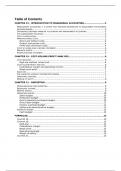Samenvatting
Summary HvA Financial & Management Accounting - Chapter 15, 20, 21
- Instelling
- Hogeschool Van Amsterdam (HvA)
Master Financial Management with this concise summary! Ideal for students and professionals, this document simplifies key concepts from Chapters 15, 20, and 21 of Financial Management textbooks. From managerial accounting to budgeting and cash flow management, it covers everything you need to know....
[Meer zien]





